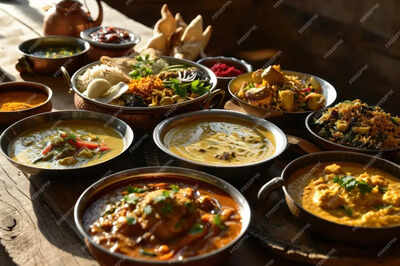ARTICLE AD BOX

For the Mughals, food wasn’t just something to eat, it was a performance. Every meal was meant to catch the eye, tempt the nose, and stay on the tongue like a memory. Their kitchens buzzed with hundreds of cooks, each devoted to perfecting one dish, while emperors expected nothing less than brilliance.
And at the center of it all were three ingredients that defined the royal table: saffron, dry fruits, and rosewater. They weren’t tossed in for effect they were the very markers of luxury, turning ordinary plates into experiences fit for kings. Scroll down to see how these three shaped the story of Mughal food.
Saffron - the emperor’s gold

A few strands of saffron could change everything. Rice would glow golden, milk desserts would smell luxurious, and gravies would feel regal.
It was brought in from Persia, and worth almost as much as gold. For the emperors, saffron wasn’t just flavor, it was prestige. Poets wrote about its glow, hakims praised its healing powers, and lovers swore by its charm. A dish scented with saffron wasn’t just served; it was displayed like treasure.
Dry fruits - richness in every bite

The Mughals loved showing abundance on their table, and dry fruits did that job perfectly. Almonds, pistachios, figs, apricots, and raisins came in from faraway lands and slipped straight into royal pots.
Qormas got richer with ground almonds, pulaos gleamed with raisins, and halwas carried the sweetness of figs and apricots. A single spoonful could be creamy, crunchy, and sweet all at once. Even now, when we scatter nuts on sheer khurma or tuck pistachios into a shahi tukda, we’re carrying forward that same Mughal instinct - to make food feel like treasure.
Rosewater - perfume on the plate

The Mughals adored their gardens, and rosewater was their way of bottling that fragrance for the dining table.
Distilled from petals, it was stirred into sherbets, sweets, and even rice dishes. The point wasn’t strong flavor - it was subtlety. A sip of gulab sherbet or a spoon of kheer carried a lingering perfume, almost like wearing a flower in your mouth. It turned meals into memories, because long after the taste faded, the fragrance stayed.
Dining as a spectacle
Eating in the Mughal court was never just about hunger. Picture silver trays lined with saffron pulao, gravies thick with nuts, desserts glistening under a film of rosewater and silver leaf.
Meals were meant to impress guests, to show off trade routes, wealth, and refinement. Every dish told a story of empire. Dinner, in a way, was politics served hot.
Still alive in our kitchens
The empire may have faded centuries ago, but its flavors never really left. The saffron in a wedding biryani, the almonds in a festive halwa, the rosewater in a gulab jamun, all carry whispers of Mughal kitchens woven into our own. What was once luxury for emperors is now the touch we add to festivals, weddings, or even a Sunday lunch when we want an ordinary meal to feel unforgettable.



.png)
.png)
.png)
















 4 hours ago
5
4 hours ago
5







 English (US) ·
English (US) ·